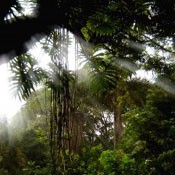This Week in Forest Carbon: Ushering in a New Year
With 2012 comes a new chapter in the forest carbon market. This week’s Forest Carbon News takes a look at how you, our loyal reader’s, ranked 2011’s top stories and what you think 2012 has in store for forest carbon.

NOTE: This article has been reprinted from Ecosystem Marketplace’s Forest Carbon newsletter. You can receive this summary of global news and views from the world of forest carbon automatically in your inbox by clicking here.
17 January 2012 | As 2012 ushers in a new chapter for the forest carbon market, the Forest Carbon news brief is taking a look back at last year’s top stories – ranked by you, our loyal readers, who shared your take on 2011 and what you think 2012 has in store for forest carbon.
Last year, the ascendant REDD+ commanded the attention of project developers, buyers, and policy makers – and our readers. Ecosystem Marketplace’s State of the Forest Carbon Markets 2011 found that REDD+ supplied 67% of the volume of tonnes contracted in the primary market in 2010, revealing the expanding role of forest carbon credits in the voluntary market.
A number of stories also saw forests growing on compliance market decision-makers. New Zealand currently stands alone as the only active marketplace crediting forestry activities (albeit, only domestically generated credits). California and Australia crept in, though, with the passage of forest-friendly legislation last year.
In Australia, the new Carbon Farming Initiative will allow land-owners to generate land-based carbon credits from project types like conservation and afforestation/reforestation. Aussies regulations also establish a cap-and-trade program by 2015, bringing around 500 of Australia’s largest emitters under compliance and providing new opportunities for domestic and international project developers.
California’s Air Resources Board overcame a series of legal obstacles throughout 2011 to launch its GHG compliance program in 2012 – with the cap-and-trade component formally beginning in 2013. Although the program will initially only credit U.S.-based emissions reduction projects, including forestry, its framework allows for international offsets in the future – particularly REDD+ credits, given the Golden State’s key role in the Governors’ Climate and Forests Task Force.
The EKO Green Carbon Fund (GCF) was launched at the beginning of this year, investing in improved forest management projects across the U.S. that are being designed with eligibility under California’s cap-and-trade program in mind. Although credits have yet to be issued and California’s program has yet to begin, the fund inspired some market confidence, acquiring BP Alternative Energy as an investor.
ERA Ecosystem Restoration Associates was also busy developing a North American forest carbon project, the Darkwoods Carbon pilot project in Canada. Partnering with the Nature Conservancy of Canada, the project sold a first round of 700,000 credits to the Pacific Carbon Trust and ERA.
The UNFCCC talks again showed themselves to be a frustrating experience, although some significant movement occurred. Taking place in Durban, South Africa, the impasses that had reared their heads in 2010’s climate negotiations, and throughout the year in 2011, were on show at COP 17. Although REDD+ made some progress, the finance question was left to be resolved during discussions in the new year. At the same time, new life was breathed into Kyoto, albeit with some big players sitting out this round.
While 2010 saw the Verified Carbon Standard developing a number of REDD methodologies, the dividends came in 2011, when project developer Wildlife Works garnered the first Voluntary Carbon Units (VCUs) issued by VCS. VCS CEO David Antonioli was certainly excited, saying “This is a watershed moment for REDD projects everywhere because it demonstrates they can attract private investment to this critical work.”
Indonesia featured in our news briefs throughout the year – sometimes with good news, like when the country’s president signed a moratorium banning concessions on forested land and peat swamps. Other times the “bad” outweighed any progress, like when the Rimba Riya project area was halved to grant a concession to a palm oil company. Despite disappointments and setbacks, money continues to flow into Indonesian REDD, with investment bank the Macquarie Group partnering with Flora and Fauna International, to the tune of $25 million, to develop projects in Indonesia.
And while ERA wasn’t queasy about launching a project in a country known for political instability, the Overseas Private Investment Corporation signed a deal with Terra Global Capital to provide “political risk insurance” covering Terra Global’s investment in REDD projects in Asia. The first insurance contract was signed in November, providing $900,000 in political risk insurance for a REDD project in Cambodia.
Those were the biggest stories of 2011, according to our reader poll. Some of you also chimed in with predictions for 2012. Will California lead the way in North American carbon markets utilizing forest carbon credits? Will 2012 would be the year for the launch of a sub-national jurisdictional REDD program? Read on for more reflections and predictions from those in the know.
—The Ecosystem Marketplace Team
If you have comments or would like to submit news stories, write to us at [email protected].
![]()
|
|
|
ABOUT THE FOREST CARBON PORTAL The Forest Carbon Portal provides relevant daily news, a bi-weekly news brief, feature articles, a calendar of events, a searchable member directory, a jobs board, a library of tools and resources. The Portal also includes the Forest Carbon Project Inventory, an international database of projects including those in the pipeline. Projects are described with consistent ‘nutrition labels’ and allow viewers to contact project developers. |
|
ABOUT THE ECOSYSTEM MARKETPLACE Ecosystem Marketplace is a project of Forest Trends, a tax-exempt corporation under Section 501(c)3. This newsletter and other dimensions of our voluntary carbon markets program are funded by a series of international development agencies, philanthropic foundations, and private sector organizations. For more information on donating to Ecosystem Marketplace, please contact [email protected]. |
Additional resources
Please see our Reprint Guidelines for details on republishing our articles.

